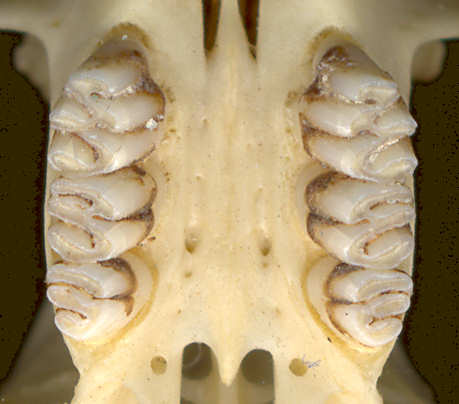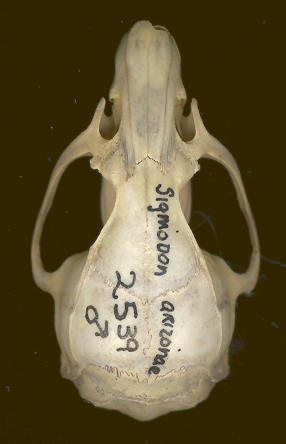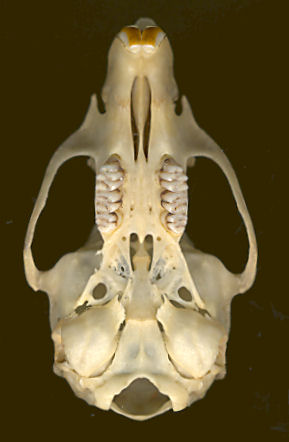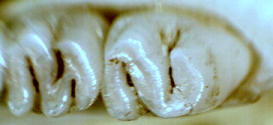Reithrodontomys—Three species of harvest mice occur in New Mexico and/or Trans-Pecos Texas. The harvest mice differ from deer mice in a number of ways, but the easiest to see concerns the upper incisors, which have a deep groove. As a group, harvest mice tend to be rather smaller than deer mice, and the facial differences, though subtle for the beginner, are quite distinctive. Most taxa are quite scansorial, often being trapped in vegetation when the effort is made. A considerable amount of arthropod food is consumed during the warm part of the year, with seeds the main food at other times. The genus is mostly a southern group, with a number of species in Mexico and Central America.
Reithrodontomys fulvescens (Fulvous Harvest Mouse) occurs in the Big Bend area and then again in extreme southwestern New Mexico (Peloncillo Mountains) and southern Arizona. This is a pattern seen in several mammals (e.g., Sigmodon ochrognathus), with the geographic range being continuous farther south in Mexico, but not including most of southern New Mexico and northern Chihuahua.
Reithrodontomys megalotis (Western Harvest Mouse) is nearly ubiquitous in our region, occurring from low desert to over 10,000 feet. This is the most widespread of our species, occurring from slightly inside of western Canada south into central Mexico, and from the West Coast east to western Indiana (though avoiding much of the Southern Plains and Southeast). In El Paso, we've taken it most commonly in weedy areas on the floodplain.
Reithrodontomys montanus (Plains Harvest Mouse) is the most northernly oriented of our species, with almost all of its range being in the Great Plains of the U.S.; it does get into southern Arizona, adjacent Sonora, and through Chihuahua to Durango, however. In our area, this is a relatively rare mouse; the Museum of Southwestern Biology (University of New Mexico) noted only about 2% of its harvest mice from the state were of this species.
Onychomys—Grasshopper Mice. These mice form a distinctive line separate from the other "peromyscines," differing in general morphology (somewhat stocky with a short tail; relatively simple molars), diet (which tends to be heavy in vertebrates and invertebrates), and even in smell. Such arthropods as scorpions often are taken, and small vertebrates may be killed by a bite through the spinal cord behind the head. Presence often is made known to mammalogists running a trapline by the discovery of partially eaten mice in kill traps. They are even known to emit pipsqueak-sized wolf howls.
Population numbers tend not to be large, perhaps because of their predatory nature, but numbers appear relatively stable. One study found approximately one Onychomys per acre. In captivity, females have produced up to 52 young per year (a potential 83 offspring per lifetime).
Onychomys arenicola (Mearn's Grasshopper Mouse) is the common southern species within our area, being limited to (a rather generous estimate of) the Chihuahuan Desert. In much of the earlier literature, this was identified as O. torridus (see below). Its range overlaps that of the Northern Grasshopper Mouse throughout much of southern New Mexico and Trans-Pecos Texas; where there is such sympatry, this species tends to be restricted to hardpan and rocky areas, leaving the sandy substrates to the Northern.
Onychomys leucogaster (Northern Grasshopper Mouse) has most of its range within the United States (unlike Mearn's, which has the bulk of its range in Mexico). Its range extends from western Canada south into northeastern Mexico and into the northern fringe of Mexico in our area. The animal is much more ecologically plastic than Mearn's; although usually in a grassland context at low elevations, it has been taken at over 9,600 feet in the Capitan Mountains. Around El Paso, it is common in the dune country.
Onychomys torridus (Southern Grasshopper Mouse), as earlier described, has been divided into the more eastern O. arenicola and the more western O. torridus. The latter barely makes it into New Mexico along the Arizona border in the southwestern part of the state. Discrimination is primarily by differences at the cellular level.
Sigmodon—Cotton Rats. As a group, cotton rats often are considered to be the warm-climate version (ecologically) of voles. They often are active diurnally (as well as nocturnally) and construct runways in grass. Four species occur in our general region. Although generally associated with grass, they are subject to large fluctuations in population numbers and spread out into other habitats during population highs.

Palate and upper toothrows of the Arizona Cotton Rat (Sigmodon arizonae)


Dorsal and ventral views of the skull of the Arizona Cotton Rat (Sigmodon arizonae).
 The generic name comes from the "S"-shaped
cusps of the third molars, as seen in the accompanying figure of m3.
The generic name comes from the "S"-shaped
cusps of the third molars, as seen in the accompanying figure of m3.
Sigmodon arizonae (Arizona Cotton Rat) originally was recognized by chromosomal data as being separate from S. hispidus. Once the two species were recognized from these data, morphological differences were found. The Arizona Cotton Rat barely enters New Mexico along the Arizona border in the southwestern part of the state. Its overall range is along the western edge of Mexico from near the southern border of Sinaloa north to the southern tip of Nevada. Its range divides the main body of the geographic range of S. hispidus from that of an isolated population of hispidus in the lower Colorado River Valley.
Sigmodon fulviventer (Tawny-bellied Cotton Rat) occurs in southwestern New Mexico and, north from about central New Mexico to the Albuquerque area, in the Rio Grande Valley. To the south, it extends deep into Mexico, but predominantly on the Central Plateau. Where it overlaps with other species, it tends to be found in thicker, less-disturbed grassy areas. Historically, this species has expanded its northern geographic limits and replaced the Hispid Cotton Rat in the more northern portions of the Rio Grande Valley.
Sigmodon hispidus (Hispid Cotton Rat) is the common cotton rat in the Southern High Plains, southeastern United States, and much of Mexico south into Panama. Historically, it has moved far northward in the plains from its limits in the early part of the century. Where this species overlaps with the Tawny-bellied, it tends to stick to the less well-grassed, more disturbed areas.
Sigmodon ochrognathus (Yellow-nosed Cotton Rat) is a primarily Mexican montane form that enters southeastern Arizona-southwestern New Mexico to the west and the Davis and Guadalupe mountains to the east. The Guadalupe Mountains record is relatively recent , it not having been captured there in mammalogical studies before the middle of the century. Where this species occurs with the other two species in Hidalgo County, NM, it tends to stick to the mountain slopes in a more diverse habitat than occupied by the other two species. This species will occur as high as open pine forest.
Last Update: 1 Feb 2008
Centennial Museum and Department of Biological Sciences, The University of Texas at El Paso